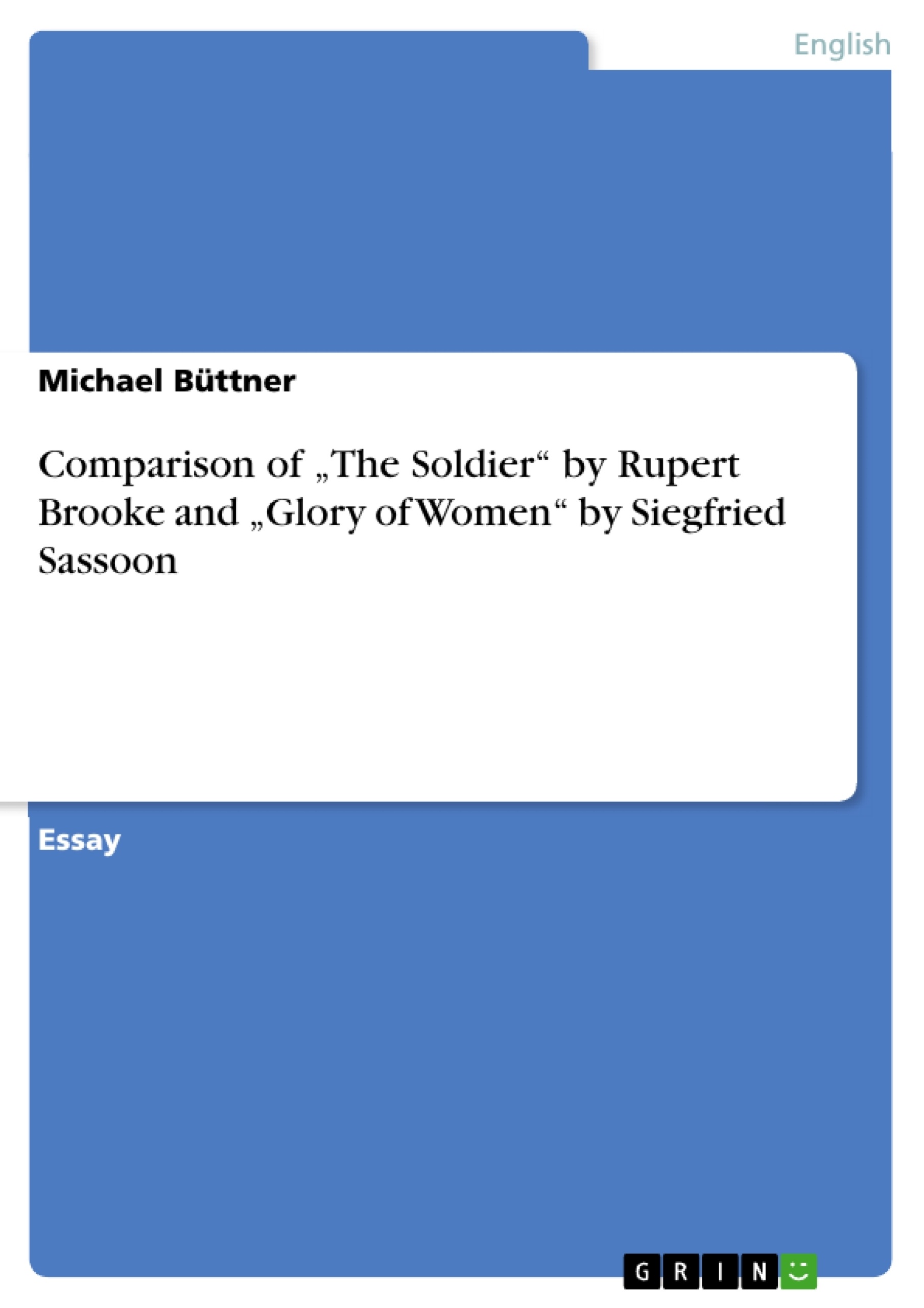This term paper, on one hand, will analyse the war sonnet „The Soldier“ by Rupert Brooke (1914) in detail, on the other hand, it will compare the results to the analysis of „Glory of Women“ by Siegfried Sassoon (1918). The focus will be laid on the close-up study of „The Soldier“, while „Glory of Women“ will be mainly used to show differences between the authors and their poems.
Table of Contents
- 1. Introduction
- 2. Analysis of „The Soldier“
- 2.1. Form
- 2.2. Syntactic analysis
- 2.3. Semantic analysis
- 2.4. Content analysis / Interpretation
- 3. Comparison of „The Soldier“ and „Glory of Women“
- 4. Conclusion
Objectives and Key Themes
This term paper analyzes Rupert Brooke's "The Soldier" (1914) and compares it to Siegfried Sassoon's "Glory of Women" (1918). The primary focus is a detailed analysis of "The Soldier," using "Glory of Women" to highlight contrasting perspectives. The paper aims to illuminate the differing portrayals of war and patriotism in these two works.
- Patriotism and its representation in wartime poetry
- The contrasting perspectives of Brooke and Sassoon on war and death
- Formal analysis of poetic structure and language
- The use of stylistic devices to convey meaning and emotion
- Communicative situation and implied audience in war poetry
Chapter Summaries
1. Introduction: This introductory chapter sets the stage for the comparative analysis of Rupert Brooke's "The Soldier" and Siegfried Sassoon's "Glory of Women." It outlines the paper's objectives: a detailed examination of "The Soldier" and a comparative analysis with "Glory of Women" to highlight the differences in their approaches to the themes of war and patriotism. The chapter establishes the scope and focus of the subsequent analysis.
2. Analysis of „The Soldier“: This chapter provides a comprehensive analysis of Brooke's "The Soldier," examining its formal structure (a Spenserian sonnet with iambic pentameter and specific rhyme scheme), syntactic structure (divided into three parts with distinct thematic focuses), semantic analysis (exploring the communicative situation and lack of specific addressee), and an interpretation of the poem's content. Key aspects discussed include the portrayal of England as a source of comfort and the idealized vision of death for a soldier dying for his country. The analysis explores the poem's use of stylistic devices, such as personification and alliteration, and considers the possibility of the poem being an euphemism despite its seemingly peaceful tone.
3. Comparison of „The Soldier“ and „Glory of Women“: This chapter compares and contrasts Brooke's "The Soldier" and Sassoon's "Glory of Women," focusing on their formal similarities and differences in communicative situation and content. The analysis points out that both poems are Spenserian sonnets, but their communicative situations, addressing the audience, and overall messages differ significantly. While Brooke's poem presents an idealized and romanticized view of death in war and intense patriotism, Sassoon's work offers a stark contrast, portraying the horrors of war and critically examining the glorification of conflict. The contrasting views on patriotism between these two poems form a crucial point of comparison.
Keywords
World War I poetry, Rupert Brooke, Siegfried Sassoon, "The Soldier," "Glory of Women," patriotism, war, death, stylistic analysis, sonnet, communicative situation, euphemism, contrasting perspectives.
Frequently Asked Questions: Analysis of Rupert Brooke's "The Soldier" and Siegfried Sassoon's "Glory of Women"
What is the main focus of this academic paper?
This paper provides a detailed analysis of Rupert Brooke's "The Soldier" (1914) and compares it to Siegfried Sassoon's "Glory of Women" (1918). The primary goal is to illuminate the contrasting portrayals of war and patriotism presented in these two works, using a close reading of "The Soldier" as the foundation.
What are the key themes explored in the paper?
The paper explores several key themes, including patriotism and its representation in wartime poetry, the contrasting perspectives of Brooke and Sassoon on war and death, formal analysis of poetic structure and language, the use of stylistic devices to convey meaning and emotion, and the communicative situation and implied audience in war poetry.
What aspects of "The Soldier" are analyzed in detail?
The analysis of "The Soldier" includes a comprehensive examination of its formal structure (Spenserian sonnet, iambic pentameter, rhyme scheme), syntactic structure (divided into three thematic parts), semantic analysis (exploring communicative situation and lack of specific addressee), and an interpretation of its content. The analysis also explores the poem's use of stylistic devices like personification and alliteration and considers the possibility of the poem being an euphemism despite its seemingly peaceful tone.
How does the paper compare "The Soldier" and "Glory of Women"?
The comparison focuses on the formal similarities and differences between the two poems, particularly regarding their communicative situations, audience, and overall messages. While Brooke's poem presents an idealized and romanticized view of death in war and intense patriotism, Sassoon's poem offers a stark contrast, portraying the horrors of war and criticizing the glorification of conflict. The contrasting views on patriotism form a central point of comparison.
What is the structure of the paper?
The paper is structured as follows: an introduction outlining the objectives; a detailed analysis of "The Soldier"; a comparative analysis of "The Soldier" and "Glory of Women"; and a conclusion. The Table of Contents provides a more detailed breakdown of the chapters and sub-sections.
What keywords are associated with this paper?
Key words associated with this paper include: World War I poetry, Rupert Brooke, Siegfried Sassoon, "The Soldier," "Glory of Women," patriotism, war, death, stylistic analysis, sonnet, communicative situation, euphemism, contrasting perspectives.
What is the intended audience for this paper?
This paper is intended for academic use, focusing on a structured and professional analysis of themes found within the selected poems.
- Quote paper
- Michael Büttner (Author), 2013, Comparison of „The Soldier“ by Rupert Brooke and „Glory of Women“ by Siegfried Sassoon, Munich, GRIN Verlag, https://www.grin.com/document/282999




